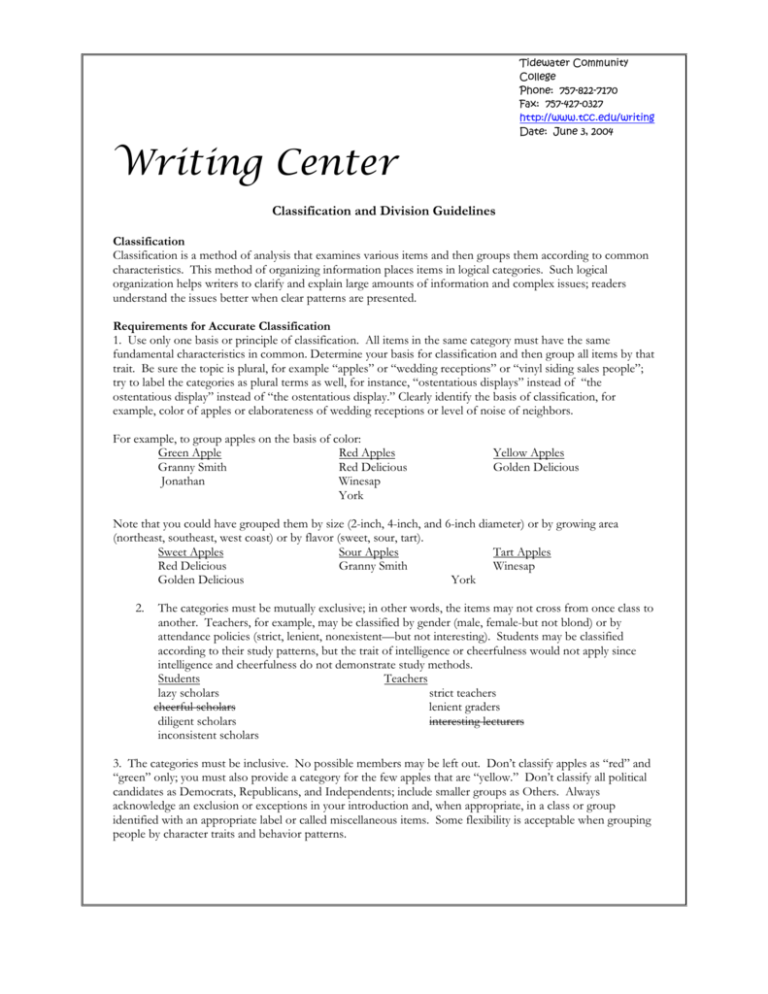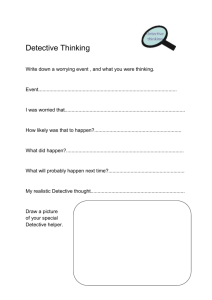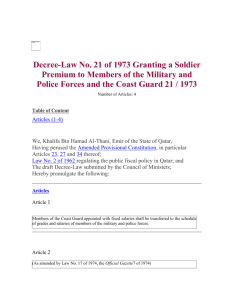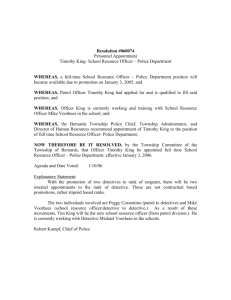Classification and Division Guidelines
advertisement

Tidewater Community College Phone: 757-822-7170 Fax: 757-427-0327 http://www.tcc.edu/writing Date: June 3, 2004 Writing Center Classification and Division Guidelines Classification Classification is a method of analysis that examines various items and then groups them according to common characteristics. This method of organizing information places items in logical categories. Such logical organization helps writers to clarify and explain large amounts of information and complex issues; readers understand the issues better when clear patterns are presented. Requirements for Accurate Classification 1. Use only one basis or principle of classification. All items in the same category must have the same fundamental characteristics in common. Determine your basis for classification and then group all items by that trait. Be sure the topic is plural, for example “apples” or “wedding receptions” or “vinyl siding sales people”; try to label the categories as plural terms as well, for instance, “ostentatious displays” instead of “the ostentatious display” instead of “the ostentatious display.” Clearly identify the basis of classification, for example, color of apples or elaborateness of wedding receptions or level of noise of neighbors. For example, to group apples on the basis of color: Green Apple Red Apples Granny Smith Red Delicious Jonathan Winesap York Yellow Apples Golden Delicious Note that you could have grouped them by size (2-inch, 4-inch, and 6-inch diameter) or by growing area (northeast, southeast, west coast) or by flavor (sweet, sour, tart). Sweet Apples Sour Apples Tart Apples Red Delicious Granny Smith Winesap Golden Delicious York 2. The categories must be mutually exclusive; in other words, the items may not cross from once class to another. Teachers, for example, may be classified by gender (male, female-but not blond) or by attendance policies (strict, lenient, nonexistent—but not interesting). Students may be classified according to their study patterns, but the trait of intelligence or cheerfulness would not apply since intelligence and cheerfulness do not demonstrate study methods. Students Teachers lazy scholars strict teachers cheerful scholars lenient graders diligent scholars interesting lecturers inconsistent scholars 3. The categories must be inclusive. No possible members may be left out. Don’t classify apples as “red” and “green” only; you must also provide a category for the few apples that are “yellow.” Don’t classify all political candidates as Democrats, Republicans, and Independents; include smaller groups as Others. Always acknowledge an exclusion or exceptions in your introduction and, when appropriate, in a class or group identified with an appropriate label or called miscellaneous items. Some flexibility is acceptable when grouping people by character traits and behavior patterns. Writing A Classification Essay Introduction The introduction of a classification essay must establish a context for and the significance of the classification. Why are you classifying the items? What is the basis of classification that you are using? How did you determine the classes? For example, if you are classifying athletic shoes, perhaps you are doing so in order to warn people against buying fashionable shoes that are harmful to their feet instead of the less chic shoes engineered for a particular activity. Your basis for classification could be price or sport of design. Alternatively, you may wish to classify your teachers in order to convince your parents that all of them are excellent instructors. Your basis of classification could be lecture techniques, typed of work required, or professional qualifications. If you have experience with diets that don’t work, you may wish to classify diets to show that they all have faults. You could use as your basis for classification the caloric requirements or the promotional techniques or the nutritional deficiencies. Every night between six and seven p.m., millions of Americans turn on their television sets to watch the evening news. For most people, this hour provides their only exposure to national events. Although cable television and satellite dishes make ten or twelve shows available, most people watch only one of these three types of show. Based on reporters’ delivery style on the most popular news shows, there are three primary approaches to the news: upbeat, low-key, and intense. Have you ever tried to order a mean in a fashionable restaurant from a waitress wearing a frilly white blouse and severe black ankle-length skirt while she told you about her periodontal surgery or her mother-in-law’s interference in her marriage? Such familiarity can interfere with the pleasure of dining out. One of the most influential people in the restaurants, the waitress or waiter is as important as the chef for determining diners’ pleasure. Over the past en years my sister and I have dined out at least once a month and have discovered that four typed of server are common in local restaurants. According to their manner toward customers, they are chatty servers who share personal problems with patrons, reticent servers who hardly speak unless spoken to, overeager servers who fill the water glasses whenever takes a sip, and ignorant severs who can’t tell customers whether the broccoli is fresh or frozen. Body Paragraphs At the beginning of each body paragraph, clearly identify the class you are preparing to discuss. Use either a descriptive label or a descriptive phrase. Present the particular characteristics that distinguish the category. This identification of category and traits will probably be part of your topic sentence for the paragraph. Develop and support your classification with sufficient, specific, concrete examples that illustrate the characteristics. Be sure to include lists of items typical of the category and representative examples with concrete, specific details. If you are presenting traits that are similar to or different from the same traits in the other classes, present them in the same order for each paragraph: Savory omelets are the most popular of the three types. These omelets have meat or vegetable filling or possibly herb fillings; combination of meat, vegetables, and herbs also may fill savory omelets. For example, many vegetarians like omelets filled with chopped onions and mushrooms or with broccoli and cheese. Carnivores tend to prefer ham or bacon fillings. True gourmands enjoy the classiest omelets, into which they fold imported caviar or truffle shavings. The best savory omelets, however, like the best pizzas, have no more than three fillings; otherwise the flavors become lost in a jumble of cheese, onions, peppers, mushrooms, ham, bacon, and parsley. Or: Servers who are overly eager to please annoy many diners. Usually, these severs are in the way, standing too close or grabbing dishes still being used. For instance, some over-eager waiters hover around the table, asking, “Is everything alright?” or “Would you like some more ketchup?” They whisk away the breed plate before diners finish the best part, the crunchy crust. At a Virginia Beach restaurant least week, for example, the waitress tried to take away my pecan pie plate when there were just crumbs left, annoying me because I intended to eat every crumb. Other zealous waiters and waitresses stand with a pitcher of water, adding to the glass every time a patron takes a sip. The most bothersome of these servers are the ones who never leave the side of the table, ensuring that diners eat more and talk less because of lack of privacy. Some Ideas for Classification Topics These topics are suggestions. Select topics for which you can present at least two or three categories and plenty of supporting examples. Choose a topic familiar to you from your own experience and observation unless you teacher wants you to base your essay on reading. Pick a topic that will be interesting to you and your readers. If you do use outside sources, document them accurately. Note that you must work with groups of various items, not with individual items. liars tools attitudes toward money, sex, religion, spouses siblings censorship or a holiday like Christmas offspring customers cashiers dates blind dates contemporary music sales clerks roommates jobs in a particular field local neighborhoods concert audiences athletic event crowds fast food restaurants tourists shoppers soap opera or game shows bars dance clubs study methods hangouts neighbors marriage snobs managers, bosses, or coaches parents methods for financing education, recreation, luxury purchases, or houses Division Division is a method of analysis and organization that examines a single item or a single type of item by separating it into its component parts. As a result of such division, writer and reader understand • the parts • the relationship of the parts to each other • the relation of the parts to the whole item • the whole item Division differs from classification in that division deals with individual items while classification deals with groups of items. Division deals with a single unit while classification deals with collections of items. Some essays may use both classification and division in order to make their points. For example, while classification might describe the several types of airplanes according to engine size or engine type or commercial purpose, division would analyze one airplane and discuss its parts: cockpit, wings, wheels, engines. In another situation, classification would identify the types of television sets according to controls of furniture design would examine that parts of a representative set: picture, tube, cabinet, control knobs, electrical system. Classification Paragraphs and Essays—Models Christmas Gifts adapted from John Langan, English Skills, 2nd ed., New York: McGraw-Hill, 1981 Christmas gifts can be divided into three groups, according to their after-Christmas fates. For example, some Christmas gifts are welcome and used. Whether an expensive cashmere sweater, a dishwasher, an interesting book, or a jogging suit, such gifts are perfect for their recipients. They are used as soon as possible, and everyone appreciates them. The second type of gifts falls halfway between being hated and being loved. Here the thought counts but the gift doesn’t suit the recipient. These gifts include ties that do not match the recipients’ suits, blouses that are too big, woolen socks that cause itchy feet, and chocolate truffles that spoil diets. The ties and blouses and socks are consigned to the back of shelves and closets; the candy is hidden behind the low-calorie salad dressing on the cupboard shelf until it hardens too much to be eaten. Finally, certain gifts fit the category of instant banishment. On December 26, these gifts go back to the department store or into the trashcan. For example, shiny purple parachute-cloth pants from Aunt Elsie and Uncle Ernie immediately become dust cloths. Lamp shaped like apples go to a corner of the attic, and monogrammed toilet paper fuels the Christmas week fire. Most people want the first type of gift, resignedly appreciate the second type of gift, and appropriately disdain the third type of gift. Collectively, these gifts show the diversity of Christmas giving. Book Owner by Mortimer J. Adler, from ‘How To Mark a Book,” Saturday Review, 1940 There are three kinds of book owners. The first has all the standard sets and best-sellers—unread, untouched. This deluded individual owns woodpulp and ink, not books. The second has a great many books—a few of them read through, most of them dipped into, but all of them as clean and shiny as the day they were bought. This person would probably like to make books his own, but is restrained by a false respect for their physical appearance. The third has a few books or many—every one of them dogeared and dilapidated, shaken and loosened by continual use, marked and scribbled from front to back. This man owns books. Types of coral reefs by F.D. Ommanney from The Shoals of Capricorn, 1952 Rpt in Norman A. Brittin, A Writing Apprenticeship, 2nd ed., 1968 There are three main types of coral reef. The first is the fringing reef which lies just off the main shore, separated from it by a narrow and shallow lagoon. It is this kind of reef which encircles Mauritius like a girdle, leaving between itself and the coast of the island a shallow stretch of water, in places only a few hundreds yards wide but in others, as at Grand Port, expanding to a width of two miles or more. Fringing reefs, too, encircle many of the islands that we visited such as Coevity and Angalega and, though irregular and broken in places, lie off part of the coast of Mahe and Praslin in the Seychelles. Down the east coast of Africa from Cape Guardafui to the coast of Portuguese East there runs an almost continuous coral reef, which is mostly of the fringing type. The second type is the barrier reef, which lies at much greater distance from the coast than the fringing reef and may be several miles wide with channels through it, and is separated from the mainland by a wide lagoon. The most famous example of this type is the Great Barrier Reef off the eastern coast of Australia. It is over a thousand miles long. In its northern half the barrier may not be more than twenty or thirty miles from the Queensland coast, but in its southern half it is as much, as fifty or one hundred miles from the coast and consists of several parallel reefs with channels between them. The third type of reef is the atoll, a ring of growing corals crowned with palm trees, often hundreds of miles from any true land and rising abruptly in the ocean a depth of thousands of fathoms. In the Chagos Islands, we found true atolls at Diego Garcia and Peros Banhos, irregular rings of coral rock and sand which lush vegetation has taken root, and on which plantations have long been cultivated by man. In the Aldabra groups, seven hundred miles south west of the Seychelles, we found coral reefs of varying degrees of perfection. Television Detectives Student Model Detective programs, which are usually fast paced and exciting, are among the most entertaining television programs. Viewers come to see the detectives as clever, capable, and strong. However, most of these shows present unrealistic characteristic characters and situations that underestimate the intelligence of viewers. Three types of detective insult viewers on these shows: private citizens, police officers, and private officers, and private investigators. The first and most numerous category of unrealistic television detectives is private citizens. These detectives have no legal authority but somehow always become involved in criminal activities, often solving crimes that police cannot. “Murder, She Wrote” for example, depicts Jessica Fletcher, an aging author who lives in a small Maine village and bicycles around the villiage, solving a new every other day. By expecting viewers to believe such a small village has so much and varied crime, the writers of the show treat viewers as idiots. Another example of private citizen detective is “The A-Team,” which depicts four former soldiers who fight gangsters, loan sharks, unjust landlords, and military regimes in order to right the wrongs in the world. The A-Team fights with machine guns and explosives, but even though the A-Team works in the middle of the city, police officers never respond to the lively chatter of the machines guns or the dull boom of the explosives. That the police never respond is incredible. The second type of television detective that challenges credibility is the police officer such as “Hunter.” These police officers sometimes at illegally themselves as they solve crimes; otherwise, they are much more clever than the other police. Hunter’s duty is to uphold the law, but he beats a criminal senseless in every episode. When he finds the informant or criminal that he is seeking, Hunter beats the criminal until he gives Hunter the information he wants. For a viewer to believe that the criminal would not report this beating to the proper authorities is unimaginable, showing the writers have a blatant disregard for the intelligence of the average viewer. Another example of the police officer television detective is “T.J. Hooker,” who has been a police officer for twenty-five years and has solved every crime ever committed. Hooker never does paperwork. He also never adheres to the rules and regulations; in fact, he ignores them. By expecting the viewer to believe that a police detective’s work is so cut and dried, the writers prove that they fail to see the viewer as an intelligent adult. The third type of television detective that insults the viewer is the private investigator. Some P.I.s used to be police; working for themselves, however, gives them incredible powers of deduction and strength. “Magnum P.I.” is an example. He is usually hired by a rich industrialist to find a pretty girl, a long lost brother, or a missing kidnapped child. Although Magnum is searching for one person in a city of at least half-a-million people, Magnum always finds the person he is looking for. If real private investigators possessed the skills Magnum possesses, kidnappers, would think twice before kidnapping somebody. Another example of the private investigator type appears on the program “Riptide.” Cody, Rick, and Murray are the investigators. When they move quickly, they use Rick’s helicopter to move from place to place. Although Rick is able to pilot a helicopter, he never does have an aviator’s license. Somehow, the FAA never arrests Rick for illegally flying an aircraft. Cody, Rick, and Murray also utilize a robot in their investigations. The robot can electronically tap into National Crime Agency’s computer, generate images of criminals whose names have been entered into the robot’s keyboard, and open beer cans for Rick and Cody. By expecting the viewers to believe such details, the writers demonstrate the contempt they feel for viewer’s intelligence. Television programs that feature private citizens, police officers, and private investigators are all entertaining and provide fast-paced drama with a touch of humor. Although these programs are enjoyable, they are unrealistic and insulting to the intelligence of the average viewer. Therefore, while detective shows are excellent entertainment, for a realistic intellectual stimulation, television cannot substitute for a well-written novel. Copyright for this document is held by the Writing Center and Grammar Hotline of Tidewater Community College, Virginia Beach Campus. It has been written, revised, and/or edited by staff paid to perform that work for the college; therefore, the rights are retained by the college. 11/26/03







